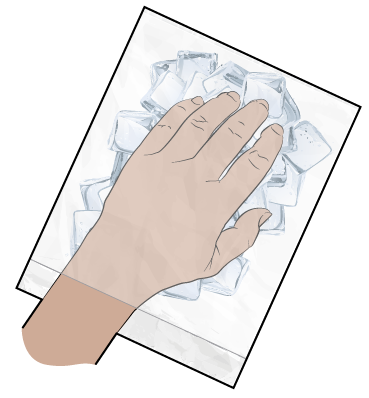This information explains nail changes that you may have while taking taxane-based chemotherapy and how nail cooling can help you manage these changes.
Your fingernails and toenails may change if you’re taking a type of chemotherapy medication known as taxanes. There are a few kinds of taxane chemotherapy medications. The taxane chemotherapy medications that most often cause nail changes are:
- Docetaxel (Taxotere®)
- Paclitaxel (Taxol®)
- Albumin-bound paclitaxel (Abraxane®)
Nail Changes Caused by Taxane Chemotherapy
You may have any of the following nail changes in some or all of your nails:
- Changes in the color of your nails (dark or light)
- Grooves or ridges
- Nails that break more easily
- Changes in nail shape or texture
- Nail splitting
- Nail separation from the skin below. This may or may not be painful.
- Discharge or fluid from under the nail. It may or may not smell bad and be painful. This may or may not be an infection.
- Swelling in the tips of your fingers or toes
- Slow nail growth
- Growth on the side of your nails
These nail changes can involve your nail plate, nail bed, the area around or under your nail, or all of these areas (see Figure 1).

Figure 1. The parts of your nail
Nail changes can be different for everyone. Some people don’t experience any nail changes, while others experience a wide range of symptoms.
These changes may stop you from doing your usual activities. It may be hard to pick up small things such as a pen or a fork. You may have trouble buttoning your clothes. Some people have trouble walking.
Once the taxane chemotherapy is stopped, your nails should begin to improve and eventually return to normal. This healing may take time because nail growth is a slow process. For more information about how to care for your nails while on taxanes, read our resource Nail Changes During Treatment .
Nail Cooling
Cooling the nails on your hands and feet during taxane chemotherapy may help to minimize nail changes. Nail cooling is most effective in helping to keep your nail from separating from your skin. It’s important to check with your healthcare provider before using nail cooling to ensure there are no contraindications (reasons why using nail cooling might be more harmful then beneficial).

Figure 2. During nail cooling
During nail cooling
Your nurse and other members of your healthcare team will wrap your hands, feet, or both in ice packs or ice bags, at least 15 minutes before you start chemotherapy (see Figure 2). The ice will stay on throughout your treatment and will be removed 15 minutes after your chemotherapy ends. The ice may need to be changed during your treatment if it starts to melt. It’s important to keep the ice on during the recommended time so that you can fully benefit from the cooling.
Effectiveness of nail cooling
Studies have found that people who use nail cooling have fewer changes in their nails than people who don’t. There’s also new research that suggests cooling of the hands and feet can help prevent peripheral neuropathy. The effects are different for everyone, so it’s hard to predict how this will affect you. However, nail cooling is safe and has few risks.
Side effects of nail cooling
Most people are able to use nail cooling without any problems. Some people find the ice to be uncomfortable and too cold. It may also prevent you from using your hands and moving around during treatment. Some people stop the cooling because of these side effects.